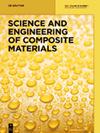The influence of water vapor on the structural response of asphalt pavement
IF 1.6
4区 材料科学
Q3 Materials Science
引用次数: 0
Abstract
Abstract A series of water damage phenomena of asphalt pavement during service show that water is very important. To comprehensively analyze the influence of water vapor factors on the response of pavement structure, this article first tests the water vapor diffusion coefficient of asphalt pavement materials at different temperatures establishes the water vapor concentration field model of the pavement structure, and analyzes the actual water vapor distribution of the pavement structure; then, the relationship between viscoelastic parameters of the mixture and water vapor concentration is established. Based on this, the finite element model of the pavement structure considering the water vapor factor is established, and the influence of the water vapor factor on the pavement structure response and fatigue life is quantified. It is found that water vapor has an important influence on the mechanical response. On the hottest days in summer, the attenuation of surface modulus caused by water vapor has the greatest impact on the upper layer of the pavement structure. Under the influence of water vapor, the position just below the wheel of the upper layer at the bottom of the horizontal tension strain increases by 108.26%, and the horizontal tension strain of the other layers increases by about 5%, increasing the risk of upper layer cracking. At the same time, water vapor reduces the stress that can be borne by the surface layer, while the rest of the stress is borne by the base. Compared with the fatigue life calculation method in the specification, the actual non-uniform water vapor concentration field reduces the fatigue life of the surface layer by 12.246%. This shows that the current structural calculation does not consider the water vapor factor, which makes the pavement structure more dangerous, and the influence of the water vapor factor should be fully considered.水蒸气对沥青路面结构响应的影响
摘要沥青路面在使用过程中出现的一系列水损害现象表明,水是非常重要的。为了全面分析水蒸气因素对路面结构响应的影响,本文首先测试了不同温度下沥青路面材料的水蒸气扩散系数,建立了路面结构的水蒸气浓度场模型,分析了路面结构实际的水蒸气分布;然后,建立了混合物的粘弹性参数与水蒸气浓度之间的关系。在此基础上,建立了考虑水蒸气因素的路面结构有限元模型,定量分析了水蒸气因素对路面结构响应和疲劳寿命的影响。研究发现,水蒸气对机械响应有重要影响。在夏季最热的日子里,水蒸气引起的表面模量衰减对路面结构上层的影响最大。在水蒸气的影响下,位于水平拉伸应变底部的上层车轮正下方的位置增加了108.26%,其他层的水平拉伸应变增加了约5%,增加了上层开裂的风险。同时,水蒸气减少了表面层可以承受的应力,而其余的应力由基底承受。与规范中的疲劳寿命计算方法相比,实际不均匀的水蒸气浓度场使面层的疲劳寿命降低了12.246%。这表明目前的结构计算没有考虑水蒸气因素,这使得路面结构更加危险,并且应充分考虑水蒸气因素的影响。
本文章由计算机程序翻译,如有差异,请以英文原文为准。
求助全文
约1分钟内获得全文
求助全文
来源期刊

Science and Engineering of Composite Materials
工程技术-材料科学:复合
CiteScore
3.10
自引率
5.30%
发文量
0
审稿时长
4 months
期刊介绍:
Science and Engineering of Composite Materials is a quarterly publication which provides a forum for discussion of all aspects related to the structure and performance under simulated and actual service conditions of composites. The publication covers a variety of subjects, such as macro and micro and nano structure of materials, their mechanics and nanomechanics, the interphase, physical and chemical aging, fatigue, environmental interactions, and process modeling. The interdisciplinary character of the subject as well as the possible development and use of composites for novel and specific applications receives special attention.
 求助内容:
求助内容: 应助结果提醒方式:
应助结果提醒方式:


